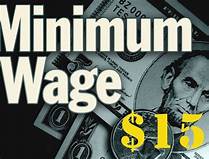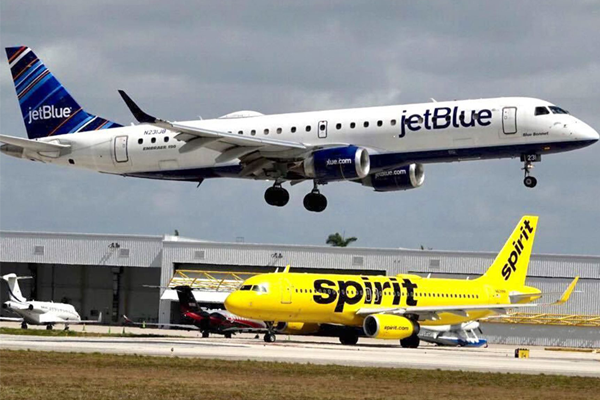
Although the U.S. House of Representatives has voted to increase the federal minimum wage from the $7.25 an hour it’s been stuck at for decades, there’s little chance the Senate as currently constituted will follow suit and approve raising the minimum wage to $15 over a six-year period.
In contrast to this Congressional stalemate, there’s been a growing push in many states for higher minimum wages. Over the past decade, 29 states and the District of Columbia have raised their minimum wages above the federal floor. In the spring, Maryland and Connecticut joined New Jersey, Illinois, New York, California, Massachusetts, and the District of Columbia in enacting legislation to raise the minimum wage, in stages, to $15 an hour.
Nevertheless, many workers in the other 21 states still labor under a woefully outdated federal minimum wage law that has left far too many working for families in or near poverty and contributed to heightened income polarization. That includes many thousands of men and women working in county agencies, school districts, and other local governments.
Most of the policy focus around raising the minimum wage has been on employment and earnings impacts in the private sector, with very little attention to the effect on local government workers. When the topic has been discussed, often it takes the form of worries about further cost pressures on already tight local budgets, and, in extreme cases, possibly even triggering tax increases or reductions in public services. This is the equivalent of the pushback in the private sector that higher minimum wages will lead employers to cut jobs and hours.
A new report, “The Impact of Increased Minimum Wages on Local Government” released by The Century Foundation, examines the likely effects on local government budgets of a $15 minimum hourly wage. It finds that:
· A $15 minimum wage would directly impact about a quarter of local government workers nationwide.
· Once spillover effects on those earning slightly more than $15 an hour are taken into account, closer to one-third such workers are likely to see higher wages after a move to a $15 minimum wage.
· In the 21 states still at the federal $7.25 minimum, 40 percent of local government workers would be affected by a move to $15.
· While this would mean raises for a significant portion of the local government workforce, the annual cost of a phased-in $15 minimum wage in six annual steps is actually substantially less than general wage increases local governments implemented during the 2013-2017 period. (2017 is the latest year for local government occupational wage data by state used in this analysis.)
In fact, the impact on local government expenses would be significantly less than some may fear. Where $15 minimum wage laws have already been enacted, the cost of getting all local government workers over that threshold has been relatively small as a share of total local wage costs, averaging a little over a half percent per year until the threshold is reached for each jurisdiction.
While paying for a $15 minimum wage for local government workers will not be as easy elsewhere, it shouldn’t be impossibly onerous either.
The new report conservatively estimates, for example, that to phase into $15 an hour over six years, local governments in the 21 states still governed by the $7.25 federal minimum wage requirement would have to raise total wages by an average of 1.5 percent annually. However, that’s a fraction of the average 2.2 percent annual wage increases local governments in these states paid from 2013 to 2017. Local governments in the 24 states with higher minimum wages, but that hadn’t yet adopted $15-an-hour legislation as of the end of February of this year, would face average annual wage increases of almost one percent; they have increased local government worker wages in recent years by an average of 2.4 percent per year.
Can local governments afford this? It certainly looks from the data as though the cost is manageable and within the bounds of wage increases provided in recent years. In fact, the estimates presented here overstate the additional cost, since they do not incorporate wage increases paid over the past two years when unemployment has been low, and wages increased more for state and local government employees than they did during the 2013-2017 period. For financially strapped local governments, state governments should utilize their more extensive – and less regressive – revenue bases to help.
Given the critical importance of public human services provided by nonprofit contractors that primarily benefit children and vulnerable populations, their employees shouldn’t be left behind, either. State and local governments also need to step up and increase contract funding needed to raise wages for these often underpaid care workers. For example, when New York State acted to raise the minimum wage in New York City to $15 an hour by the end of 2018, Mayor Bill de Blasio and the City Council increased funding in human services contracts to enable nonprofits to pay the higher wages. Other local governments should follow that lead.
Momentum is finally building around the country to raise the minimum wage to $15 an hour. A growing body of research has found that, counter to some fears, the higher minimum wages already enacted haven’t reduced private sector employment opportunities, and that they push businesses to become more efficient. Similarly, a higher minimum wage for local government and public school employees is not only doable; it will also foster greater workforce retention, improve the quality of service delivery, and significantly benefit the incomes and well-being of millions of families and their communities.
JAMES A. PARROTT IS DIRECTOR OF ECONOMIC AND FISCAL POLICIES AT THE CENTER FOR NEW YORK CITY AFFAIRS AT THE NEW SCHOOL.



